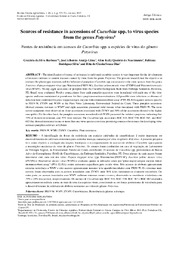Sources of resistance in accessions of Cucurbita spp. to virus species from the genus Potyvirus.
Sources of resistance in accessions of Cucurbita spp. to virus species from the genus Potyvirus.
Author(s): BARBOSA, G. da S.; LIMA, J. A. A.; NASCIMENTO, A. K. Q. do; SILVA, F. R.; DIAS, R. de C. S.
Summary: The identification of source of resistance in cultivated cucurbits species is very important for the development of resistant cultivars to control diseases caused by virus from the genus Potyvirus. The present research had the objective to evaluate the phenotypic reactions and the behavior of pumpkin (Cucurbita spp.) accessions to the virus species from the genus Potyvirus: Papaya ringspot virus type Watermelon (PRSV-W), Zucchini yellow mosaic virus (ZYMV) and Watermelon mosaic virus (WMV). Twenty-eight accessions of pumpkin from the Cucurbit Germplasm Bank from Embrapa Semiárido, Petrolina, PE, Brazil were evaluated. Twelve young plants from each pumpkin accession were inoculated with each one of the virus species and were maintained at greenhouse for their symptom reaction evaluations. All possible virus infections or absence of infection were confirmed by plate-trapped antigen enzyme linked immunosorbent assay (PTA-ELISA) against antisera specific to PRSV-W, ZYMV and WMV at the Plant Virus Laboratory, Universidade Federal do Ceará. Three pumpkin accessions showed extreme resistant to WMV and eight accessions presented mild mosaic when inoculated with PRSV-W. The most severe symptoms were observed on those accessions inoculated with ZYMV and 50% of the accessions showed to be highly susceptible. On the other hand, the pumpkin accessions inoculated with WMV presented the mildest symptoms, indicating that 39% of them were resistant, and 39% were tolerant. The Cucurbita spp. accessions BGC 518, BGC 530, BGC 567, and BGC 683 that showed resistance to one or more than one virus species constitute promising sources of resistance for developing virus resistant pumpkin cultivars or hybrids.
Publication year: 2017
Types of publication: Journal article
Unit: Embrapa Semi-arid Region
Keywords: Abóbora, Cucurbita spp, Cucurbits, Cucurbitácea, Disease, Doença, Hortaliça, Potyvirus, Pumpkin, Resistência, Virus
Observation
Some of Embrapa's publications are published as ePub files. To read them, use or download one of the following free software options to your computer or mobile device. Android: Google Play Books; IOS: iBooks; Windows and Linux: Calibre.
Access other publications
Access the Agricultural Research Database (BDPA) to consult Embrapa's full library collection and records.
Visit Embrapa Bookstore to purchase books and other publications sold by Embrapa.

